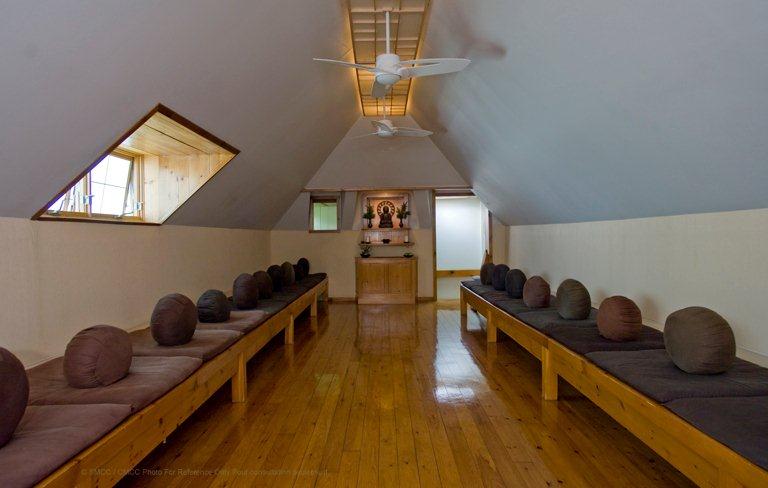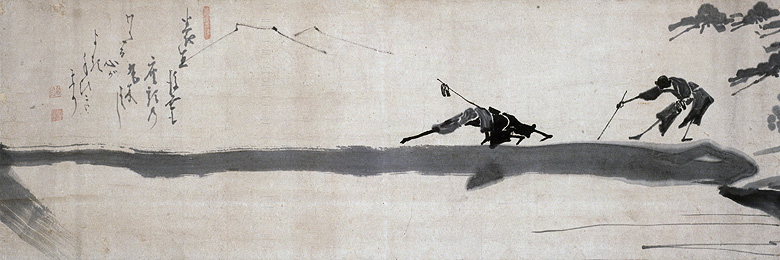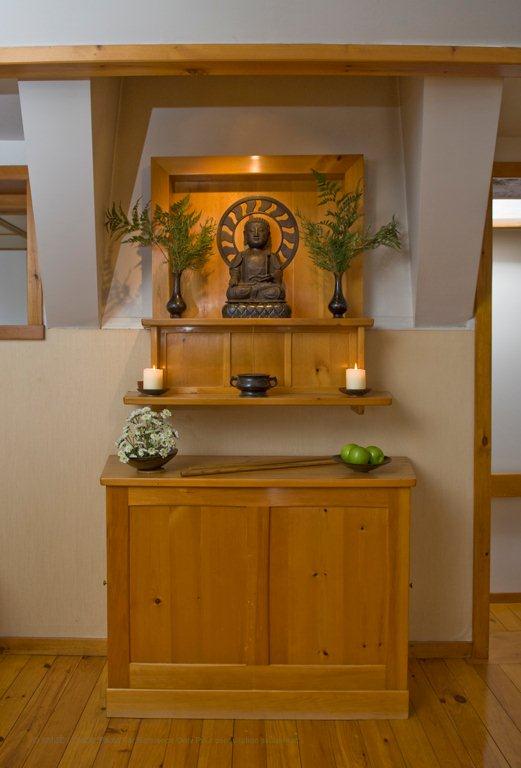Sesshins
It is said that the word “sesshin” means “one mind”.
One could say that sesshins are the jewels of practice at the Montreal Zen Centre. They offer participants an unequaled opportunity to engage with others in intensive meditation for a prolonged period of time.
From September 2018 to May 2019, five sesshins will be held at the Centre : one seven-day sesshin, one four-day sesshin, one three-day sesshin and one two-day sesshin. In January 2019, American-born teacher Jeff Shore will come in for the second time to lead a five-day retreat.
Two-day sesshins are “introductory sesshins”. They allow new members to familiarize themselves with all aspects of a sesshin. New members are urged to take part in a two-day sesshin before attempting to take part in sesshins of longer duration.
As for three, four, five and seven-day sesshins, they are designed to emphasize the need for the patient and sincere effort that the practice requires. They help us to let go of those life habits that keep us asleep and to plunge without restraint into a practice of sustained attention and awakened vigilance, without relenting, during many consecutive days.
Sesshins take place under the direction and guidance of a core of senior monitors who have been students of Albert Low for many years.

.jpg)
Daily schedule
The daily schedule, which is the same for a two-day, four-day or seven day-retreat is as follows:
- 5:30 - Wake-up bell
- 6:00 - Zazen
- 7:10 - Breakfast
- 7:30 - Work period
- 8:30 - Rest period
- 9:30 - Zazen
- 10:07 - Teisho
- 11:17 - Zazen
- 12:25 - Lunch
- 13:30 - Zazen
- 15:20 - Chanting
- 15:45 - Exercises
- 16:25 - Zazen
- 17:00 - Supper
- 17:20 - Rest period
- 19:00 - Zazen
- 20:45 - End of zazen
- 21:00 - Tea
- 23:00 - Night sitting (voluntary but highly recommended)
- 00:30 - End of night sitting
Everyone registering for a retreat commits to respect this schedule and to practice from moment to moment, throughout each activity. Silence is maintained from the first day to the last, and participants keep their eyes lowered in all circumstances.
Zazen and teishos
Each period of zazen (sitting meditation) is of thirty minutes’ duration, followed by walking meditation, kinhin, for 7.5 minutes. One of the fundamental rules of zazen is physical immobility. In front of a wall, one is alone with oneself and, even as tensions gradually appear in search of some outlet, one does not move. The profound silence that arises from deep breathing is marked by the crack of the kyosaku: a step in the natural and intuitive practice of zen.

Each day, mid-morning, a recorded teisho is played. During his years as director of the Centre, Albert Low recorded over one thousand teishos and we draw on this precious heritage to provide our practice with a strong and determining momentum. Listening to teishos is another form of zazen: sitting in formal zazen position with faces turned to the centre of the room, all participants listen with open hearts to these living words.
Words of encouragement, reminders and texts read by monitors at different times during sesshins also contribute in maintaining an atmosphere of attention and vigilance conducive to a deepening of the practice.
By clicking on the link below, you will access the detailed sesshin guidelines. Your presence at a sesshin implies that you have read them and that you agree to respect them.
Sesshins guidelines.pdfRegistration
For obvious reasons, sesshins are reserved exclusively to members. (becoming member)
To register, you should forward your request by email at the following address: retraite.czdm@gmail.com at least two weeks prior to the date on which the sesshin is scheduled to begin. By clicking on the link provided, you will access the required form.
Do not forget to indicate whether you have any physical disabilities that could prevent you from performing certain tasks or whether you wish to sit on a chair or “kneeling-chair”. You should very soon receive an acknowledgment of the receipt of your application. If not, please resend your request.
Two weeks prior to the sesshin, you will receive a reply confirming that your application has been accepted or denied. If you have been accepted, we ask that you immediately confirm that you have received the acceptance. Your name will be placed formally on the registration list only after we have received your confirmation.
The fee for participating in a sesshin is $65 per day, $32 for students.
The Chanting Ceremony
Chanting plays a small, but nevertheless an important part of sesshin. Each afternoon of the sesshin a chanting ceremony is held which lasts about twenty minutes. There are also chants before meals and at the close of the day's formal activities. The afternoon ceremony includes 'The Prajna Paramita Hridaya Sutra', the ten-verse 'Kannon Sutra' and the Four Vows.
Although chanting does not take up much sesshin time, the chants, particularly the Four Vows, represent a necessary part of Zen practice.
Zen Chanting is very vital. It is accompanied by the steady beat of a mokugyo, a round wooden drum, and accompanied by the striking of a keisu, a large bowl-shaped gong. On the whole, one chants around a monotone with hara as the source of the chanting. During a sesshin chanting is both an inspiration and welcome relief.

The Three Refuges
(Standing, hands in gassho, facing altar)
- I take refuge in Buddha ...........(full prostration)
- I take refuge in Dharma...........(full prostration)
- I take refuge in Sandha............(Full prostration)
(Take a seat facing centre of zendo)
HEART OF PERFECT WISDOM
- The Bodhisattva of Compassion, from the depths of prajna wisdom,
- saw the emptiness of all five skandhas
- and sundered the bonds of suffering.
- Know then: Form here is only emptiness, emptiness only form
- Form is no other than emptiness,
- Emptiness no other than form.
- Feeling, thought and choice, consciousness itself, are the same as this.
- Dharmas here are empty, all are the primal void.
- None are born or die,
- Nor are they stained or pure, nor do they wax or wane.
- So in emptiness no form, no feeling, thought or choice,
- Nor is there consciousness.
- No eye, ear, nose, tongue, body, mind;
- no colour, sound, smell, taste, touch, or what the mind takes hold of,
- nor even act of sensing.
- No ignorance or end of it, nor all that comes of ignorance:
- no withering, no death, no end of them.
- Nor is there pain, or cause of pain, or cease in pain,
- or noble path to lead from pain.
- Not even wisdom to attain, attainment too is emptiness.
- So know that the Bodhisattva, holding to nothing whatever,
- But dwelling in prajna wisdom, is freed of delusive hindrance,
- rid of the fear bred by it, and reaches clearest nirvana.
- All buddhas of past and present, buddhas of future time,
- through faith in prajna wisdom come to full enlightenment.
- Know then the great dharani, the radiant peerless mantra,
- the supreme, unfailing mantra, the Prajna Paramita, whose words allay all pain.
- This is highest wisdom, true beyond all doubt, know and proclaim its truth:
- Gate, gate, paragate, parasamgate, bodhi, sva-ha!

KANZEON!
(lead chant introduces Kanzeon by chanting it once through and then giving the introducing "Kanzeon" - all come in on the "Praise....)
- Kanzeon!
- Praise to Buddha
- All are one with Buddha
- All awake to Buddha.
- Bouddha, Dharma, Sangha,
- Freedom, joy and purity.
- Through the day Kanzeon,
- Through the night Kanzeon,
- This thought comes from Buddha-mind,
- This thought is one with Buddha-mind.
Return of Merit
(lead chant introduces Return of Merit - hands in gassho)
- Ten Direction, Three Worlds,
- All Buddhas, Bodhisattva-mahasattvas
- Maha Prajna Paramita.
Four vows
(Kneel upright, facing altar, hands in gassho. Lead chant introduces The Four vows: "All beings without number")
- All beings, without number, I vow to liberate.
- Endless blind passions, I vow to uproot.
- Dharma gates, beyond measure, I vow to penetrate.
- The Great Way of Buddha, I vow to attain.
(Stand, facing altar, hands in gassho. Three prostrations.)
Hakuin Zenji’s Chant « In Praise of Zazen »
At the end of the formal activities 'Hakuin Zenji's Chant in Praise of Zazen' and the Four Vows are chanted.
Hakuin was a seventeenth-century Japanese Zen master. He was a deeply awakened man and his teaching helped to inspire a revival of interest in Zen practice in Japan.
- From the beginning all beings are Buddha.
- Like water and ice, without water no ice,
- outside us no Buddha.
- How near the truth yet how far we seek;
- like one in water crying ‘I thirst!’
- Like a child of rich birth wandering poor on this earth,
- we endlessly circle the six worlds.
- The cause of our sorrow is ego delusion.
- From dark path to dark path we wander in darkness.
- How can we be freed from the wheel of samsara?
- The gateway to freedom is zazen samadi.
- Beyond exultation, beyond all our praises, the pure Mahayana.
- Observing the precepts, repentance and giving,
- the countless good deeds, and the way of right living, all come from zazen.
- Thus one true samadhi extinguishes evils;
- It purifies karma, dissolving obstructions.
- Then where are the dark paths to lead us astray?
- The pure lotus land is not far away.
- Hearing this truth heart humble and grateful,
- to praise and embrace it, to practice its wisdom,
- brings unending blessings, brings mountains of merit.
- But if we turn inward and prove our True nature,
- that True Self is no self,
- our own Self is no-self,
- we go beyond the ego and past clever words.
- Then the gate to the oneness of cause and effect is
- thrown open.
- Not two and not three,
- straight ahead runs the Way.
- Our form now being no-form,
- in going and returning we never leave home.
- Our thought now being no-thought,
- our dancing and songs are the voice of the Dharma.
- How vast is the heaven of boundless samadhi!
- How bright and transparent the moonlight of wisdom!
- What is there outside us, what is there we lack?
- Nirvana is openly shown to our eyes.
- This earth where we stand is the pure lotus land,
- and this very body, the body of Buddha.
The Meal Chant
Before meals, the Meal Chant is chanted. This chant asks us to remember the toil of others and to be be moderate in all things. All chants should be done mindfully and with vigor.
To invoke the compassionate nature is to awaken to the sufferings of others and to arouse the will to work for the salvation of all.
Food is symbolically offered to hungry and thirsty ghosts. This is a very ancient ritual, and in Zen it is interpreted to mean that an offering is made to appease those parts of ourselves which are too restless, so greedy for attention and thirsty for sensation, that they cannot join in with the practice but are always striving to pull away from it.
(hands in gassho)
(leader)
- With all that lives, let us honor the Three Treasures,
- Let us recall the exertions of Buddhas and Bodhisattvas.
(All)
- This meal is the labor of countless beings,
- let us remember their toil.
- Gluttony stems from greed,
- let us be moderate.
- Our lives are sustained by this offering,
- let us be grateful.
- We take this food to attain the Buddha Way.
(food is served)
(All, with raised bowls or plates)
- Our meal is offered to Buddha, Dharma and Sangha.
- With teachers and family, with nations and all life
- let us equally share.
- To beings throughout the six worlds, we offer this meal.
(plates set down, hands in gassho)
- All hungry ghosts!
- All tortured spirits!
- Now we give you this Dharma-food.
- May it fill the ten directions
- and satisfy hunger in realms of darkness.
- All hungry ghosts!
- All tortured spirits!
- Abandon greed and rouse the desire for enlightenment.
- To you spirits tortured by thirst, we give this liquid offering.
- May your thirst be relieved,
- May your suff’ring diminish,
- May all beings attain Buddhahood!